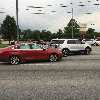'97 high-mount brake light "rebuild" FINALLY DONE!
EDIT: Adding the details to the first post now that the project is finished.
OK, I finally got tired of trying to figure out this stupid 21" neon high-mount brake light problem, and in the process ended up with two lamp assemblies. So, after searching for the best fix, I finally decided to gut one of the assemblies, and build by own LED array to put inside it. Here is what I did ....





I hope this helps. Let me know if there are any questions.
EDIT: Adding the details to the first post now that the project is finished.
OK, I finally got tired of trying to figure out this stupid 21" neon high-mount brake light problem, and in the process ended up with two lamp assemblies. So, after searching for the best fix, I finally decided to gut one of the assemblies, and build by own LED array to put inside it. Here is what I did ....
- After removing the assembly from the truck, and the lamp from the assembly, I baked the lamp in the oven at about 200-250 for 15-20 minutes, or just long enough to be able to "peal" off the lens. After doing that, removing the neon lamp, and cleaning it up, here is what I had.
- Here is the assembly after being baked, and cleaned up, and the neon lamp removed, with some measurements shown:
- Next, I had to find some LEDs. I finally found some that would work and purchased them from Super Bright LEDs:
- I ended up settling on the 8 candella RED (RL5-R8030), but after seeing it all done, I'd probably go with the 12 candella if I did it again (RL5-R12008), as they are brighter, and have a sharper viewing angle. You can always tone down the brightness if it is too bright, and although I could brighten mine up a bit, it would mean less protection for the LEDs.
- Next I found a piece of breadboard to mount the LEDs to. You can probably find something at Radio Shack, but you might have to make a two piece array, depending on the size you get, and how long you actually want your array to be. Notice in the image above that the assembly is about 3/4" tall, but since the back of the housing is curved, the array needs to be thinner than that so that it can fit comfortably down inside, so the lens does not hit the LEDs.
- I cut the breadboard so that it would fit inside the housing. When doing this, measure carefully so that the breadboard will fit down inside the housing, otherwise the LEDs will touch the lens and you'll have trouble putting it back together. Learn from me - I had to do a lot of fine tuning to get everything assembled.
- After determining how many LEDs I wanted, and how far apart they should be, I placed the leads through the breadboard and glued them in place. Be sure they are pushed down all the way, and are flat, or your LEDs won't line up perfectly, which is easy to see with these small viewing angle LEDs.
- Next, I soldered the LEDs and resistors to make the arrays. I have 3 arrays of 5 LEDs each. You can use this link to help determine the resistor size needed for each array:
- Here is the LED array in progress. This was the dry run, before cutting the breadboard and glueing the LEDs.
- After cutting, glueing, soldering, and wiring up the array, I was ready for the fine tuning, and fitting into the housing. Sorry, I forgot to take a picture of that, but you get the idea.
- I searched high and low for just the right glue to use, but in the end I just used hot glue on the array, and clear RTV to glue the array into the housing, seal any extra holes (I brought both wires out a single hole), and glue the lens back on. I also used electrical tape to hold stuff together while it was drying. I did it in stages and let everything fully dry before I put the lens back on.
- Here is a BAD picture of the array finished, and everything dry fit.
- And finally, with everything glued and dry, I took the plug off the old ballast and used that on the new LED array. Make sure you feed the wires through the hole in the tailgate before placing the plug on the wires (I had to go back and cut mine off again
)
- After reinstalling on my truck, here is what it looks like.
I hope this helps. Let me know if there are any questions.










